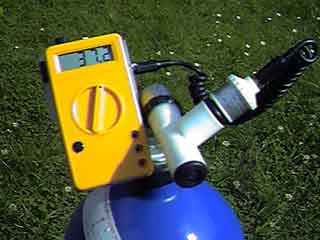|
DIY Oxygen Analyser So far, I've made 2 analysers. They both utilise the Omni
Components supplied International Technologies M-03F oxygen sensor. The finished prototype is here A few modifications were made to Dave's design. Firstly,
I didn't need the timing circuitry as the unit would derive it's power
from the multimeter. Next, the multi-turn pot was unavailable from Maplin's
and rather than purchase an expensive alternative, I decided an 18 turn
trimmer pot (79p) would do the trick. The downside to this is that you
need to fabricate a spindle and knob to adjust it. This was achieved by
filing the end of a rivet until it fit securely into the adjustment screw.
The knob was then glued into place at the other end.
The next job was to construct an adaptor to actually sample
the mix. Once again, a prototype design and a more functional design were
created. Both began life as a plastic overflow 'T' piece. The prototype
basically consisted of the T, a reducer insert and Epoxy resin. I won't
go into details about this one, suffice to say it was adequate (see the
above photo) but far from ideal. From this, Mk2
and Mk3 were born.
Not being happy with only owning 1 analyser, I decided
to make another (well 2 if the truth be known). |

